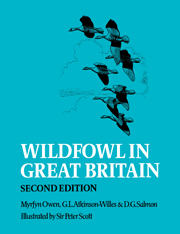Book contents
- Frontmatter
- Contents
- List of location maps
- Foreword by William Wilkinson
- Acknowledgements
- Conventions and abbreviations
- Part I Introduction
- Part II The survey of wildfowl habitat and distribution
- Part III Species accounts
- Part IV The conservation of wildfowl and their habitats
- Introduction
- The influence of man
- The management of stocks
- Conservation
- Conclusion
- References
- Indexes
Conservation
Published online by Cambridge University Press: 04 August 2010
- Frontmatter
- Contents
- List of location maps
- Foreword by William Wilkinson
- Acknowledgements
- Conventions and abbreviations
- Part I Introduction
- Part II The survey of wildfowl habitat and distribution
- Part III Species accounts
- Part IV The conservation of wildfowl and their habitats
- Introduction
- The influence of man
- The management of stocks
- Conservation
- Conclusion
- References
- Indexes
Summary
Aims and criteria
The aims of wildfowl conservation
Wildfowl have long been appreciated by man, as a source of both food and enjoyment, either through sport or sheer appreciation of their beauty, wildness and behaviour. Given the background of pressures and possibilities described in previous chapters, the role of conservation is to ensure a future for wildfowl in a constantly changing environment. Following discussions in the late 1950s between the Nature Conservancy, the Wildfowlers’ Association of Great Britain and Ireland and the Wildfowl Trust, a statement of aims was agreed in 1960. The purpose of wildfowl conservation was stated as (a) to safeguard species from the threat of extinction, and (b) to maintain existing stocks in at least their present strength and in their present distribution.
No species or subspecies was in danger of extinction in Britain in the early 1960s, and since that time changes in numbers have almost invariably been upwards or merely short-term fluctuations as a result of environmental conditions. We must reserve this responsibility as our overriding aim, however, and restate it here.
As we have seen in Part III, the aim of maintaining stocks and distribution has been more than achieved in the last 20 years, indeed several species have increased in number and spread during that time. These increases have been brought about for different reasons. In the case of Dark-bellied Brent and, to a large extent other species of geese, the increases have been a result of a lowering of shooting pressure, helped by favourable breeding seasons, and can be regarded more as a recovery than a real advance.
- Type
- Chapter
- Information
- Wildfowl in Great Britain , pp. 526 - 549Publisher: Cambridge University PressPrint publication year: 1986



